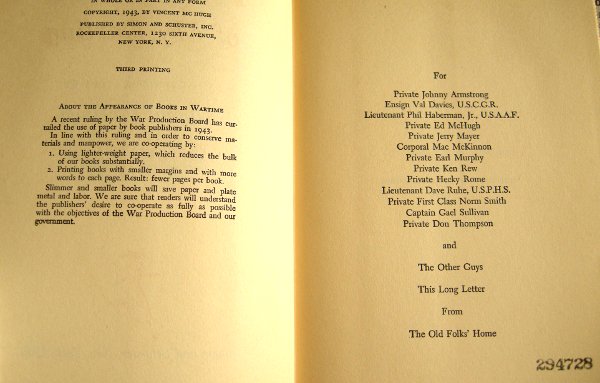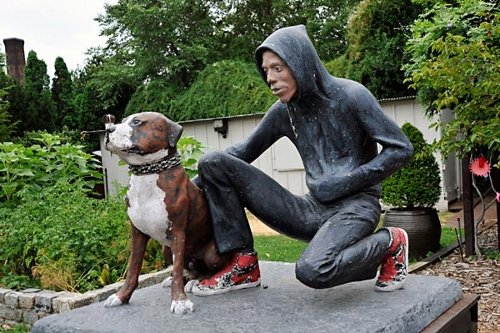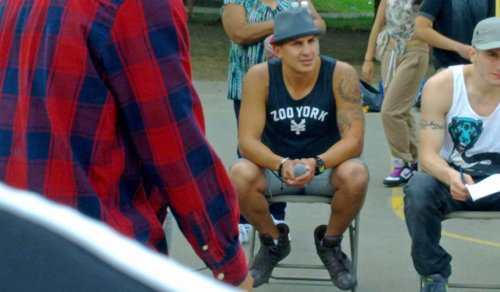As Labour Day draws near, I propose some post-summer reading to ease the transition, three books about, naturally, work - but work in the ever-green fields of utopian speculation.
By Shawn Selway
Published August 30, 2012
America, I'm putting my queer shoulder to the wheel.
-- Ginsberg
Yes, it's almost over. Time to get back to uninterrupted work or study. Time to stop just-not-thinking-about-it and resume that dreadful love/hate relationship with the formerly ambitious city.
As Labour Day draws near, I propose some post-summer reading to ease the transition, three books about, naturally, work - but work in the ever-green fields of utopian speculation - daydreams if you will, though communal, not private.

Utopia for one. Unsafe injection site in North Hamilton.
What I have in mind is a literary excursion to the capital of possibility, in the company of three industrious civil servants: Jim Rowan, a planning official suddenly promoted to Special Commissioner for Everything and asked to steer the city through a short but perilous plague of happiness; Ruth Puttermesser, demoted and humiliated First Bursary Officer in the Department of Receipts and Disbursements who is avenged by a golem which she fashions from the dirt of her houseplants; and the non-fictional and very practical dreamer John Ahearn, recipient of a 100K sculpture commission (65K goes on materials) whose work is rejected by those whom it is meant to serve.
This 1943 "Adventure Story" as it is subtitled, was re-issued in 1991, but the hardcover first edition I got on inter-library loan from Trent is interestingly marked with the signs of its original context: the obligatory notice about the exigencies of the War Production Board, and a long list of dedicatees, all absent servicemen.
McHugh's bio mentions his three other novels and his position as a staff writer with the New Yorker, and tells us that as of 1943 he was a writer in the office of the War Information Film Unit, with special interests in " city planning, jazz music, America, and the future."

Front matter, 1943 edition of I Am Thinking of My Darling.
Much of this shows in Darling, which wears its New Deal heart on its sleeve and advertises its progressivism throughout. Jim Rowan is a can-do bureaucrat by day, and an advanced sophisticate by night; a former jazz musician, a planner with a Harvard doctorate in sociology and a background in the Roosevelt administration.
From the National Resources Committee he has gone to New York as the protege of a specialist in highway planning, with whom he works at City Hall. The Washington days are now a fond, fading memory: "...The shifting from agency to board to commission, the kind of outraged social feeling deep in most of us, the finagling and the grinning at insults..."
The occasion of his ascent to the top job is an outbreak of a highly contagious fever, brought into the city by returnees from a Caribbean cruise. On the eve of the first crisis meeting, seven hundred thousand people - about ten percent of the population - have caught the bug. The symptoms, as described by the Commissioner of Health, are as follows.
...Fever of course. It seems to be a kind of euphoria. A little like three or four drinks, or even GP - but the orientation isn't affected. Improved, if anything. Great sense of well-being. Personality harmony...It seems to block the conscious controls. No will. No moral sense. No sense of responsibility. People just do what they damn please...Doesn't seem to be any violence though. Everybody's good as gold.
People who like their jobs stay in them, the rest switch, or just skip work altogether. A kind of low grade potlatch unfolds, with people helping themselves or being freely offered food drink and clothing. Scarcity ceases, and catastrophe seems imminent to the city managers who must maintain the infrastructure.
The Mayor, an early casualty, shows up at the emergency meeting just long enough to announce his resignation in favour of full-time model railroading.
The assembled commissioners and department heads fill the vacancy with the legally next in line, who will deal with the press, while our man Rowan is put in charge of actually managing the response. (Since he makes up the capital budget in his capacity as Acting Commissioner of the Department of City Planning, he has the broadest and most detailed knowledge of the entire city.)
It is agreed that a policy committee will vote on proposed measures, and Rowan will execute and report - in short, he becomes Caesar for a week, and the reader rides along as he is chauffeured about in Car One, supervising the implementation of his strategy. This consists essentially in re-organizing the city into many districts with a central station for all of fire, police, ambulance, gas, electrical and water-repair services.
Each station is linked by shortwave radio, and the size of each district is determined by the reach of the service most likely to be in greatest demand in that area.
Since "order" cannot be imposed by force - given the nature of the disease, infected troops would be completely unreliable - a threat from the right is ipso facto excluded. There remains the left to worry about: "But obviously, in the long view, they [covert Reds] couldn't afford to have progressives taking effective action in a crisis."
But nothing materializes, and the only challenge to the regime comes from a millenarian campaign against the restoration of health ie the old order of bad work and meaningless sacrifice.
The resistance is led in part by Rowan's own wife, an actress who takes to the streets to make the most of the New Day while it lasts. Rowan pursues her as best he can given his responsibilities, and comes to understand that she is working against him, playing Lady of Misrule to his King of Sobriety.
His devotion does not prevent him from sleeping with three or four other women along the way, and generally having a ball, especially after he himself gets the "happies". There is a monster traffic jam centred on Times Square, a fire in a warehouse district, and a huge parade organized by the Society for the Preservation of Happiness followed by a rally at Madison Square Garden with serious riot potential.
In accepting the position, Rowan says, "No kick like doing a job that looks just a little too big for you," and this is the tone throughout. Nothing that cool heads and good organization can't deal with, even if things are a little tight here and there. At the height of the epidemic a million and a half are infected, and one day a million people are amusing themselves at Coney Island and the Rockaways. All is tolerance and conviviality, and liberal democratic scruples survive every test.
During the showdown in committee between the forces of reaction and the rest, Rowan muses about
All the people who believed that order was a stamp press, a mold, an Iron Maiden, a double file of troops you were commanded to walk between. The people who couldn't get it through their heads by God, that order was a ball game, order was the free and healthy growth of a child. It was the means liberty took to express itself. It was the chance people had to find a way to do the things they wanted to do in common. Not holding down. Bringing out.
For good measure, McHugh has this profession repeated, this time by a Commissioner who is able to express it thus:
We have got to keep order. Is this an end in itself? I think not. By preserving pubic order we preserve the rights of each citizen. What are these rights? They make it possible for him to live with other people and that in turn makes the city possible. You know this. If we begin by cutting these rights from under us - by extraordinary police powers, or martial law, or whatever - we fail twice. We take away the citizen's rights and we prevent ourselves from doing what he has empowered us to do...our job is to keep the city running. When we fail at that, it will be time enough to try shutting it down.
For the rest, the state governor's pledge of intervention becomes redundant when a cheap remedy to shorten the ten day course of the disease is discovered. That, and a change in the weather away from the freakish warmth of a long February thaw, combine to end the epidemic.
With the exception of one neighbourhood, McHugh's city is already tantamount to utopia, because it is so very well planned. The exception of course is Harlem.
Dennis turned through the park and went up Seventh Avenue. Harlem. All the faces were colored now and people in Sunday clothes were cutting up and laughing on the street. But I knew better. I knew every last statistic. This was our failure. This was the thing that cancelled out all the other things we tried to do. This was the place where babies weren't allowed to live.
The measures that Rowan devises are effective because the organizational tools, the personnel, the communications, and the facilities are available to him when the crisis occurs. Skilled administrators and meticulous technicians have everything under control - including the internal politics of the managerial class.
New York in the forties is all progress, a steadily unfolding promise with much more and better to come. On the horizon is a grand convergence of the sciences, which are in possession of many new tools and just beginning to receive the means to orchestrate them.
Thus the epidemic prompts the establishment of the "Cass-Jordan Laboratory for the Investigation of Virus Diseases" a new beachhead in the struggle against the ills of humanity. Fade out in a glow of technological optimism.
Fifty years on, the faith in rational administration has weakened (except in the military where it continues full force, along with an undiminished enthusiasm for the technological fix) and Cynthia Ozick's high-minded heroine must resort to the supernatural to heal her city.
Puttermesser was thirty-four, a lawyer. She was also something of a feminist, not crazy, but she resented having "Miss" put in front of her name; she thought it pointedly discriminatory; she wanted to be a lawyer among lawyers. Though she was no virgin she lived alone, but idiosyncratically - in the Bronx, on the Grand Concourse, among other people's decaying old parents. Her own had moved to Miami Beach; in furry slippers left over from high school she roamed the same endlessly mazy apartment she had grown up in, her aging piano sheets still on top of the upright with the teacher's X marks on them showing where she should practice up to. Puttermesser always pushed a little ahead of the actual asignment; in school too. Her teachers told her mother she was "highly motivated", "achievement oriented." Also she had "scholastic drive". Her mother wrote all these things down in a notebook, kept it always, and took it with her to Florida in case she should die there. Puttermesser had a younger sister who was also highly motivated, but she had married an Indian, a Parsee chemist, and gone to live in Calcutta. Already the sister had four children and seven saris of various fabrics.
This is the beautifully assembled first paragraph, and the rest is all the same, except when it's better.
After law school Puttermesser goes into the firm of Midland, Reid and Cockleberry, or more precisely, into their back-office, which is the "repository of unmitigated drudgery and therefore of usable youth." But caste trumps ability and industry, and Jews do not advance in that firm, no matter how accurately dressed or Midwest standardized in speech. She quits and enters the civil service, where her idealism blossoms extravagantly.
At home, in bed, she went on dreaming and reading. She retained a romantic view of the British Civil Service in its heyday: the Cambridge Apostles carrying the probities of G.E. Moore to the far corners of the world. Leonard Woolf doing justice in Ceylon, the shy young Forster in India. Integrity. Uprightness. And all for the sake of imperialism, colonialism! In New York, Puttermesser retained an immigrant's dream of merit: justice. Justice shalt thou pursue. Her heart beat for law, even for tax law: she saw the orderly nurturing of the democratic populace, public murals, subway windows bright as new dishes, parks with flowering borders, the bell-hung painted steeds of dizzying carousels.
She rises, but eventually political preferment beats merit again, and she is displaced. Her letter of protest to the mayor, in which she invokes Whitman and Hart Crane to sting his conscience, goes unanswered, but her insolence is punished and her demotions continue.
At last, in a blind rage for justice, the functionary of New York unconsciously recapitulates the procedures of the Rabbi of Prague, and is astonished one evening to find a naked young woman asleep in her bed -a being oddly dusty to the touch when Puttermesser tries to wake her. A stupefied drug addict, no doubt, whom she commands to be gone.
The woman is mute and communicates by writing. Puttermesser weakens. The creature makes herself useful in the kitchen and is allowed to stay. One indulgence leads to another and soon Xanthippe, as she prefers to be called, is permitted to accompany her mother to the office.
There she busies herself at a typewriter for two days to produce a "PLAN for the resuscitation, reformation, reinvigoration & redemption of the City of New York."

Golem 2 (1997) by Simon Glass. Used with permission.
What follows is too good to be spoiled. Suffice to say, Puttermesser becomes mayor and utopia ensues.
Lost wallets are daily being returned to their owners. Now it is really beginning - the money and credit cards are always intact...The subways have been struck by beauty. Lustrous tunnels unfold, mile after mile. Gangs of youths have invaded the subway yards at night and have washed the cars clean...The tiles that line the stations are lakes of white...The great cargo trucks still spill into the intersections...they pant and rumble freely, unimpeded; buses and taxis overtake them effortlessly. Except for fire engines and ambulances, there are no other vehicles. Little girls dare, between buses, to jump rope in the middle of the street...There are many gardeners now, and a hundred urban gardening academies. There is unemployment among correction officers; numbers of them take gardening jobs. No one bothers to drag the steel shutters down over storefronts after closing. The Civil Service hums. Intellect and courtliness are in the ascendancy...Far away in the Bronx, the grape-wreathed heads of wine gods are restored to the white stelae of the Soldier's Monument...Nothing is broken, nothing is despoiled. No harm comes to anything or anybody...stoops sparkle, new factories and stores buzz, children gaze down in gladness at shoes newly bought, still unscratched...
Alas, as with all previous golems known to legend, this one too gets out of hand. Puttermesser has to bribe her estranged lover, a Toronto-based resettlement officer working with Russian refugees, to make love to the uncontrollable being whose lust for life, life, always more life, is destroying all that her mother has wrought.
Momentarily weakened, the thing lies unresisting on the floor as her maker erases one letter of the vitalizing inscription, the aleph, from her brow, leaving behind the mem and the tav: Death. That night, a new flower bed appears in City Hall Park.
This concludes Puttermesser's political career, though not the book, which goes on to recount much more of the life of this champion dreamer. She retreats to ideal friendship and thence to marriage, which does not last; later, childless and retired, she becomes adoptive mother to her first cousin's daughter, a visitor from the long-lost Russian side of the family.
This does not last either, as Lidia has only come to America to make a stake with which she can rejoin her boyfriend in Sakhalin. They are going into business exporting mammoth tusks. At the end, Ozick brings her character to the gates of Paradise and beyond. In fairness I should warn you that you will be made very unhappy if you accompany her all the way to the end. Paradise is not what you think, it is the very antipodes of utopia, and you will not like it.
Public art is one part art and two parts road sign, and woe to the artist who forgets or defies this fact and makes the stop sign oval. Few do, of course; most finely calculate, but the results of an error can be spectacular.
A notorious example is Marcien Lemay's statue of Riel for the Manitoba legislature grounds, which drew so much complaint that it was exiled to St Boniface and replaced in 1996 with a more "dignified" piece, this one formally equivalent to the naturalistic bronzes of Riel's enemies that occupy other Canadian public spaces.
Kramer's essay, originally published in the New Yorker in 1992, was re-packaged in 1994 with a lengthy Introduction by Catherine A. Simpson to make up a book. I didn't find Simpson's academic account of American pharisaism a useful addition, but you may.
John Ahearn is a real living person, a Catholic, an artist rather than an intellectual, and his fate has been kinder than that of Ms Puttermesser, but he has his share of troubles - with his collaborator, Rigoberto (Robert) Torres; with the thieves on the South Bronx street where he lives and works; and, during the episode which Kramer describes and analyzes here, with some of the people whom he most wants to like what he does - his neighbours.
The commissioning process itself is enough to teach the hopeful that they have a whole lot of pleasing to do. In the case of Ahearn's work for the lot next to a new police station in the Bronx, the process began in April 1986 with a panel of experts brought together by the Percent for Art Program of the New York City Department of Cultural Affairs for purposes of choosing an artist.
Fourteen people met to consider slides from twenty nine artists, of whom fifteen made it through to the next phase. At the second meeting eighteen people met to consider the work of the fifteen, plus that of seventeen more who had gotten on the list, and awarded the job to Ahearn. Three years later he received his contract.
After making up the maquettes, he took them around in 1990 for review by, among others, the Department of Cultural Services, the Department of General Services, the Police Department, City Council, the Office of Management and Budget, the office of the Mayor, and a meeting of Bronx Community Board Four, a thirty-five person board appointed by the borough president.

Raymond and Toby (1991) by John Ahearn, at Socrates Sculpture Park. Image: 12 Oz. Prophet.
Ahearn's strategy was to take the materials and postures customary in monuments to heroes and statesmen, and invert the tradition - the last became first, as it were. This move was an extension of his usual practice which was modelled on the trade in religious statues of Christian saints and Yoruba orishas sold in the city's botanicas.
Instead of plaster saints, painted plaster busts of the common people; instead of bronze heroes, a bronze roller skater. The skater was a young woman called Daleesha.
Daleesha was sassy and sly, and desperate for roller skates. John saw her skating down Walton Avenue one day on a borrowed pair and thought she looked terrific...with her skinny long legs and her stuck-up chin and her funky topknot and her South Bronx attitude...He wanted two girls skating together - Daleesha, who is black, and a Hispanic girl about the same age...Both girls gave him trouble. They weren't interested in getting a plaster cast for themselves, or in seeing themselves on pedestals, or even in being famous. Art and John Ahearn didn't interest them at all. They had one thing in mind - new roller skates-- and that was what John promised them if they were cast...
Flanking Daleesha on pedestals in front of the police station would be Corey Mann with his basketball and his boom box, and Raymond Garcia with his dog, Toby. Corey lived on Ahearn's street, was a snappy dresser with a job or two, liked to help out. Raymond was much more difficult. After losing a job as a school cleaner he got a police record. Also he used to put his dog in pit fights.
All appeared to be well until just before the unveiling (in September 1991) when a couple of professionals in the Department of General Services began to assert that the statues were racist. After the pieces were placed on site, expressions of discontent came in from several sources. The tenor was this:
"There are people who go to school and people who go to work, and then there are the people we find on the roof."
In short, Ahearn's bronzes were rejected as offensive when their particular subjects were given a permanent, prominent place in the neighbourhood. There were supporters also, but Ahearn did not want a lot of turmoil that would hinder his integration into the neighbourhood as a sort of portraitist in residence.
Needing the approbation of the community more than that of the art world, and not wanting anyone to make good on their threats to throw paint on them, he decided to remove the sculptures. He then had the problem of telling the subjects that their portraits were to be banished.
Ahearn told Kramer that his mistake was choosing to make art rather than choosing to make people happy, but his relationships with both his neighbourhood and the art world are very complicated. If Ahearn wants a casting for himself, he always makes another for the subject, and he prefers his work to be spread around in homes in the Bronx rather than in galleries elsewhere.
But it does circulate in both worlds and Kramer goes into the complications with great tact. Ahearn continues to collaborate with Torres. The pair did castings of visitors to an art show earlier this year, paid portrait commissions.

Its reputation precedes it and its culture goes everywhere. Judging breakers in Beasley Park, August 2012.
Things could be different. According to Ernst Bloch, who wrote three thick volumes about the history of this feeling (The Principle of Hope), all that is given "has utopian margins which surround actuality with real and objective possibility." Of course, most of us are rather diffident about those margins, though everyone knows they are there. But some, like Ahearn, work their way into the expandable edge of the present, and try to stay there, realizing the possibilities.
Walton Avenue is convenient - he spent two years renovating an old schoolhouse on Bonner Street that was going to be his "ultimate studio" and when he finished the landlord had him evicted - but he still prefers to cast on the sidewalk, in front of two rooms he rents on the ground floor of his own building. He and Robert pass plaster through the windows. They hang their casts out, and the neighbours know they are open for business. Or they turn on the light and pull up the blinds, and announce it that way... His last show had some casts of children in pairs - he called it Face to Face - and kids in the neighbourhood keep stopping by to check on the casts he promised them...Princess, who is nine, didn't like the colour of her face when John first cast her. She liked the yellow of her grammar-school graduation robe, but she didn't like the "slashes" of paint on her face...She wanted a light face - a "one-color face"...
And so it goes. The patient, day-by-day negotiation of the difficulties by persistent possiblists like John Ahearn and Rigoberto Torres prove the possibilities real.
For the time being, the bronzes of Daleesha, Raymond and Cory reside at Socrates Sculpture Park. Nothing has taken their place across from the Bronx police station, and Ahearn told the Times in 2008 that
There will be a day when those bronzes will be back at the police station. Things that once seemed antisocial in the past may grow into a particular symbol for the Bronx. I think those bronzes will be part of that.
From which we can take, I suppose, that much is possible, and much of the impossible is just too early - and there is only one way to find out which is which. Happy Labour Day.

43d 15' 32.0148", -79d 52' 14.1018". Utopia for all?
By Coles Notes (anonymous) | Posted August 31, 2012 at 05:18:53
"In general, try to keep your article submission around 800 words....Since online readers are notorious for 'scanning' articles rather than reading them in depth, you can't guarantee they'll slog through a laborious introduction, literature review, and painstaking argument before getting to your conclusion."
By Libravore (anonymous) | Posted August 31, 2012 at 08:36:09
Some great suggestions!
By Undustrial (registered) - website | Posted September 03, 2012 at 00:22:45
Some really good, deep thoughts here. Definitely going to keep an eye out for "I Am Thinking of My Darling".
People who like their jobs stay in them, the rest switch, or just skip work altogether. A kind of low grade potlatch unfolds, with people helping themselves or being freely offered food drink and clothing. Scarcity ceases, and catastrophe seems imminent to the city managers who must maintain the infrastructure.
This paragraph/concept really caught my attention, especially the notion of an end to "scarcity". There are certainly both utopian and catastrophic possibilities here, and some interesting insights into our society. Though "the happies" don't really exist, they're a metaphor for any number of possible reasons a sizable chunk of the population could start questioning their participation in the economy - drugs, spirituality, revolutionary politics or personal comfort/well-being, all of which did erupt two decades later in the sixties.
What if people stopped doing jobs they didn't want to do? More importantly, why do so many people have obviously awful, unrewarding and largely useless jobs? We're the most productive society in history, per hour worked, so how come we work so much?
By ltdpikoev (anonymous) | Posted December 12, 2013 at 02:29:26
Surrogate: Yet another previous Enamel Toe nail Documents winner, Bob Keene has been fronting his music group Surrogate let's focus on 5 years. The band identifies its music because jellies for slower people, despite the fact that middle pace jams for Mid west farmers has a selected ring to it. Quickly jellies regarding fast living heathens? OK, gradual jellies pertaining to slow people it really is..
We all know you would like to not really take into account the absolute depths associated with winter once the summer season sunshine remains to be brilliant. Yet booking your ideal serious winter season vacation today it is snow skiing the Rockies, discovering an exotic volcano, or simply hanging with a perfect seashore nail down a price that's within your reach.We all know, we know: You have still got a number of fine sand with your footwear. Who want to think about winter season when it's nevertheless summer time? However you should reassess, due to the fact we've 14 amazing winter destinations that could place you in world class ski slopes or even pristine sand beaches.
le pliage longchamp
Witty Ron "Tater Salad" White, most widely known regarding his / her work on nowhere Training collar Comedy Tour, will likely be headlining Saturday at the Tn Movie theater. Please remember this present is for older followers simply. Passes range between $48 for you to $58 or even make contact with the actual Tn Movie theater regarding the Ron Bright "200 Proof" Private room Expertise.
In a surprise shakeup, Yahoo provides released that it's going to always be closing Search engines Readers about Come early july 1, The year 2013. This proceed may come as Search engines attempts to merge it is solutions to set more solid wood guiding fewer arrows, as its Boss affirms. This specific loan consolidation first resulted in several providers staying rolled away below Google+ (which includes Audience along with Picasa) this year, then this lot of shutdowns throughout This year, and after this the actual shut down regarding Readers and also iGoogle in The year 2013.
sac longchamp pas cher
Sheriff's Office looking for information on compromised dumptruckMarlboro Corp. Sheriff's Business office seeking information on compromised dumptruckUpdated: Wed, November 28 The year 2013 14:Forty three 'm EST2013 12 29 16:Forty three:01 GMTMARLBORO State, Structured (WMBF) The Marlboro State Sheriff Workplace is actually looking for information on a new dumptruck that was taken from a company someday in between Sunday and Mon. The actual 1990 GMC DumptruckMore >>.
There were been recently welcome in order to Dubai in order to meet the great and also the very good via Emirates ahead of signing up for the inaugural flight returning to Luton. In keeping with the particular pioneering spirit of the North West, a new Wigan lad made it all take place Twenty five years ago practically coming from a ranking begin. Emirates Executive Vice Ceo, Sir Maurice Flanagan, originates from Leigh as well as in 1985.
longchamp le pliage large tote
You must be logged in to comment.
There are no upcoming events right now.
Why not post one?